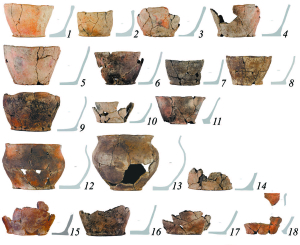 Marina E. Klemeshova*, Roman A. Mimokhod**, Nikolay I. Sudarev***
Marina E. Klemeshova*, Roman A. Mimokhod**, Nikolay I. Sudarev***
Institute of Archaeology RAS, Moscow, Russia
*E-mail: marinaklem@mail.ru
**E-mail: mimokhod@gmail.com
***E-mail: sudarev@list.ru
Keywords: necropolis, the Taman Peninsula, the Late Bronze Age, the Timber Grave culture, pottery, paste.
The article focuses on characterization of the burials of the Late Bronze Age studied at the largest Bosporan necropolis Volna 1 on the Taman Peninsula. Moreover, the paper discusses the peculiarities of identification of the burials in the context of their deposition practically in the same stratigraphic horizon as the classical ones. The Late Bronze burials belong to the Timber Grave culture of the Kuban river region. The results of the studying the paste composition of pottery from these complexes by the methods of technical and technological analysis showed fundamental difference from the paste compositions of handmade ware of classical period in that region. In the framework of absolute chronology, the time of the burial ground can be attributed to the cal. 6th–14th centuries BC. Two burials with twisted skeletons of classical period are interpreted as having features of the Timber Grave culture traditions in terms of its funeral rite.
DOI: 10.31857/S086960630013704-3







